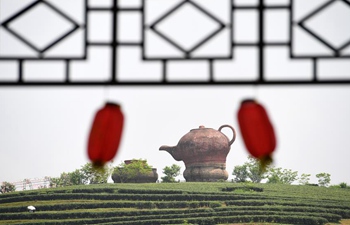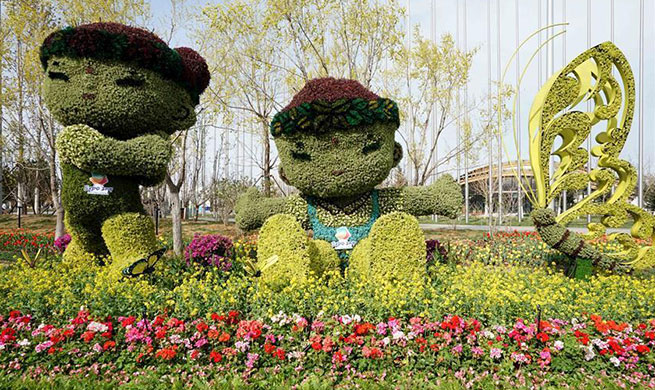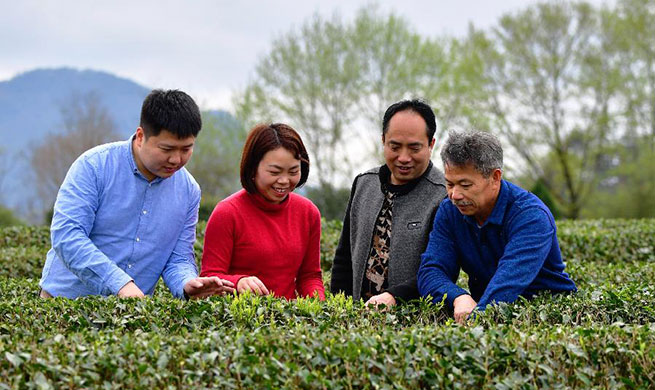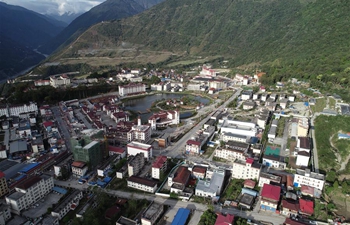By Bai Xu, Zhou Zihan, Pan Xiangyue
ADELAIDE, Australia, April 20 (Xinhua) -- If he could travel back in time, Yuan Shichao would go back to 2011 to thank himself for his "crazy" decision.
At that time, he was applying for the wine business major in the University of Adelaide in South Australia. Not accepted, he went directly to knock at the dean's door.
"I struggled to use all the English words I knew about wine," the 30-year-old man recalled. "The dean was, I think, more surprised than persuaded, but he agreed to let me have a try," he said.
It was the start of Yuan's story of wine. Now he is marketing officer with Nova Vita, a wine group in Adelaide hills of South Australia.
In the past years, he saw a boost of wine trade between China and Australia.
According to Wine Australia, Australian wine producers exported 2.82 billion Australian dollars' worth of product to the world (about 2 billion U.S. dollars) last year, of which 40 percent was sold to China, an increase of 18 percent from the previous year.
NO LONGER LUXURY
Wine, which appeared more on the screen than on dinner tables in China's ordinary families three decades ago, was once seen as an icon of petty bourgeois.
After China's reform and opening up, people's living standard is improved and the population of middle class is on the rise. With the increase of international exchanges, wine became an ordinary drink with everyday dishes in many families.
Yuan visited his father's friend in 2010 in Adelaide. "I was attracted by the vineyard," he said.
After graduation, he found a job in Nova Vita, when the wine company was about the march into Chinese market. "In Australia the demand of wine was not as high as the supply. Therefore more than half of the products would be exported. As a Chinese, I joined the company at the right time," he said.
Nova Vita was founded in 1999. Now the company boasts more than 66 hectares of vineyard, and could produce two million bottles of wine.
"In the recent years our sales growth rate was about 80 percent," Yuan said.
"During my first visit, most of the inquiries are about entry-level wine, what I call everyday drinking wine about 3 Australian dollars a bottle," Mark Kozned, managing director of Nova Vita, said. "Now most of the inquiries about wine are mid-level, something you can have at home with dinner or with good friends, or for premium wine which people tend to use for gift-giving especially around Mid-Autumn festival or the Chinese New Year," Kozned said.
CHINESE BOND GROWING
Kozned has visited China for more than 25 times since 2012, with the most recent visit the China International Import Expo (CIIE) last year.
"CIIE last year was a fantastic event. It was well put on both by the Chinese government and the organizer," he told Xinhua. "I was impressed that the Chinese business people from around China that visited really wanted to do some business," he added.
"Our achievement from the CIIE was that we gained three to four potential clients, and during the event we actually signed contracts. We discussed with three other parties post CIIE to send the wine in the next three to four months," he said.
Since participation of the CIIE, Nova Vita has received orders for more than a dozen containers of wines to China.
According to the Australian Trade and Investment Commission, China is the world's third largest market for imported wine behind the United States and Germany.
The China-Australia Free Trade Agreement further reduced the tariff of Australian wine to China to zero. "It made Australian wine in Chinese market more and more competitive. We are closing on France as the No.1 wine supplier in volume into the Chinese market," Kozned said.
Australia has also attached great importance to Chinese market. Last year, Wine Australia promoted Australian wine in China, with more than 100 companies involved.
Australia wine reached not only metropolis like Beijing and Shanghai, but also smaller cities.
Currently, Nova Vita has two branches in China, in east China's Zhejiang Province and southwest China's Chongqing Municipality. Yuan, whose hometown is in Zhejiang, spends several months each year in China doing business.
"More Chinese people joined in Australian wine companies," Yuan said. "I graduated in 2013, when I was the only one of more than 10 Chinese students to land a full-time job. Now that the Chinese students majoring in wine business haven't graduated yet, but most of them have received job offers," he said.
MORE THAN JUST A JOB
The bond between China and Australia wine is so close that Chinese people are not satisfied with just becoming employees in wine companies.
Guo Song arrived in Australia in 2007. Two years later, he bought the Jarressa Estate with friends.
In retrospect, he said that in the past three years, sales of wine in Chinese market grows at a rate of about 50 percent. In 2018, Jarressa sold more than 10 million bottles, of which 96 percent were sold to China.
He also said that China is also affecting the wine industry in Australia. "Chinese people prefer red wine to the white, and the preference affected grape planting here," he said.
With China's development and further opening up, Guo saw the wine industry as very promising.
Whereas Kozned believed that the wine like an important bridge between China and Australia. He has decided to attend the second CIIE this year. "We will spend more time in preparation, and put on better presentation," he said. "The second time, you will always do things better," he added.
Australia is to have the federal election in May. However, Kozned said that no matter who wins, and however the international trade environment changes, the wine trade between China and Australia will continue to boom. "We are like two brothers, China and Australia," he said.

















